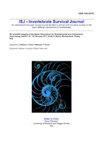Tissue biomarkers as vulnerability indicators in the clam Polymesoda caroliniana
IF 1.2
4区 农林科学
Q4 IMMUNOLOGY
引用次数: 0
Abstract
Vulnerability depends on the exposure and sensitivity levels of a system to a specific pressure, together with the capacity to cope, recover, or adapt to this pressure. We propose the use of well-known tissular techniques to measure the components of vulnerability. Immunohistochemistry and histopathology indicate the health status of living organisms and the environment. Therefore, these techniques should provide the necessary information to determine the vulnerability of an organism. Immunohistochemical analysis uses biomarkers to determine the presence of toxic compounds, reflecting the exposure level of an organism. Histopathological analysis reveals the environmental impact of a given toxin, reflecting the sensitivity level of the organism to said toxin. Here, we propose a strategy to use these techniques to assess the vulnerability of clams from Tecolutla, Veracruz. We developed categories for each vulnerability component using semi-quantitative scales. Briefly, we calculated the exposure level based on the average number of positive immunohistochemical biomarkers among several organs of clams. Then, we compared the prevalence of histological alterations with the exposure level to determine the sensitivity level. Finally, to estimate the recovery capacity, we placed the control group in a clean environment for 40 days. These led us to observe the capacity of the clams to reverse the effects of environmental stress. Clams showed a moderate level of exposure, a low sensitivity level, and an effective recovery capacity. In conclusion, these results indicate that clams have a low level of vulnerability. This proposal has the potential to guide future works assessing the vulnerability of organisms and later include them in the estimation of vulnerability from aquatic bodies.组织生物标志物在蛤蚌易损性指标中的应用
脆弱性取决于系统对特定压力的暴露程度和敏感程度,以及应对、恢复或适应这种压力的能力。我们建议使用众所周知的组织技术来测量脆弱性的组成部分。免疫组织化学和组织病理学显示生物体和环境的健康状况。因此,这些技术应提供必要的信息,以确定生物体的脆弱性。免疫组织化学分析使用生物标记物来确定有毒化合物的存在,反映生物体的暴露水平。组织病理学分析揭示了给定毒素的环境影响,反映了生物体对该毒素的敏感程度。在这里,我们提出了一种策略,利用这些技术来评估来自韦拉克鲁斯州Tecolutla的蛤蜊的脆弱性。我们使用半定量量表为每个漏洞组成部分开发了类别。简单地说,我们根据蛤的几个器官中阳性免疫组织化学生物标志物的平均数量来计算暴露水平。然后,我们比较了组织学改变的患病率与暴露水平,以确定敏感性水平。最后,为了估计恢复能力,我们将对照组置于清洁环境中40天。这让我们观察到蛤蜊扭转环境压力影响的能力。蛤类暴露程度中等,敏感性低,恢复能力强。综上所述,这些结果表明蛤蜊具有较低的脆弱性。这一建议有可能指导今后评估生物脆弱性的工作,并在以后将其纳入水生生物脆弱性的估计中。
本文章由计算机程序翻译,如有差异,请以英文原文为准。
求助全文
约1分钟内获得全文
求助全文
来源期刊

ISJ-Invertebrate Survival Journal
IMMUNOLOGY-ZOOLOGY
CiteScore
2.10
自引率
0.00%
发文量
0
审稿时长
>12 weeks
期刊介绍:
Invertebrate Survival Journal (ISJ) is an international and open access journal devoted to prompt and innovative studies on the basic defense mechanisms in invertebrates, in particular with a view to identifying biotechnologies able to act against derived diseases and related economic damage.
Contributions will be mainly in the form of Letters to the Editor, Visions and Perspectives, Short Communications, Technical Reports, Research Reports, Review, Minireview and Reports of Meetings. Letters to the Editor can be commentaries or perspectives on invertebrate defence mechanisms or replies to the data published in ISJ.
 求助内容:
求助内容: 应助结果提醒方式:
应助结果提醒方式:


